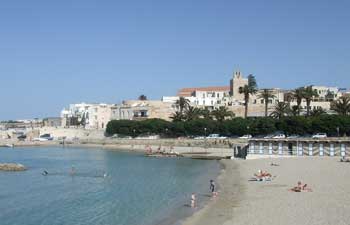About Otranto
Otranto is a historic seaside town and port on the Adriatic coast of southern Italy, in the region of Puglia. It’s a small place with a lovely holiday atmosphere, and makes a good destination for a day trip or a longer stay. The picture-perfect blue waters, white buildings and diving rocks make Otranto the frequent cover star of maps, books and articles about Puglia.
The town is in the province of Lecce, and is close to the easternmost point of Italy. It is within the area known as the Salento, the tip of the peninsula which is the heel of Italy’s boot. On a clear day it is possible to see over the Strait of Otranto to Albania. Like many of the local placenames, Otranto is pronounced with the stress on the first syllable.
The name of Otranto is probably best known abroad for The Castle of Otranto, Horace Walpole’s pioneering Gothic novel. However, the creepy castle of Walpole’s imagination bears little resemblance to the more recent stolid fortress in the real Otranto.
Like much of Puglia, Otranto has a colourful and mixed past. It was important as a Greek and then Roman port, called Hydruntum. Later it was ruled by the Byzantines, the Normans and the Aragonese. In 1480 the town was invaded by Turks, and 800 locals were executed for refusing to convert to Islam. The bones and skulls of the martyrs of Otranto are now stacked behind glass in the cathedral in a manner that would have satisfied Walpole’s Gothic imagination.
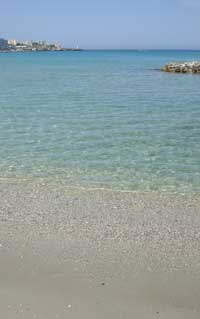
Things to see in Otranto
Otranto’s leading attraction is the twelfth-century mosaic in the town’s Romanesque cathedral (open 7am-noon and 3pm-8pm; closing earlier in winter). It is a charmingly quaint yet large-scale work carried out by a monk called Pantaleone. Pictures within the mosaic include religous stories like Noah’s ark, but also depictions of historical, mythical and even pagan figures, including Alexander the Great (similarly portrayed in the mosaic at Trani) and King Arthur. Alongside the cattedrale is a small museum, the Museo Diocesano, which contains a few local exhibits including fragments of an earlier fourth or fifth-century mosaic from the cathedral site.
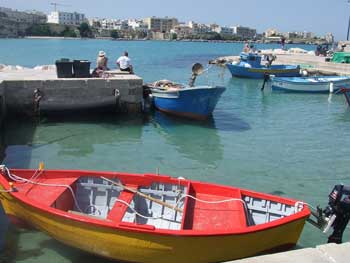
Hidden up winding alleys within the old part of town is a very different church, the little Byzantine Chiesa di San Pietro. This is an attractive small building containing Byzantine frescoes (not always open); it may once have been the principal church of Otranto.
The real-life ‘castle of Otranto’, the Castello Aragonese, is a mighty construction which forms part of the tough defences of Otranto. The current building is fifteenth-century, though it was built on one of Frederick II’s earlier fortresses. It is open to the public and sometimes houses temporary exhibitions. Otranto’s small tourist information office (not terribly helpful) lies close to the castle in Piazza Castello.
In addition to these tourist sights, visitors can simply roam the lanes of the historic town, coming across picturesque scenes and views. The centre is still enclosed within its defensive walls, which gives a real sense of history. The busiest lanes are lined with decent souvenir shops (ceramics, sandals, that sort of thing) and with restaurants and bars. On summer nights Otranto has a lively holiday scene. Up out of the atmospheric alleys, explorers can stroll along the walls above the sea, where a couple of really idyllically-sited bars allow you to sit and sip drinks or eat a light lunch while gazing over the harbour and bay. Further atmosphere can be appreciated among the crumbling ruins above the harbour, which include a stone altar open to the sky.
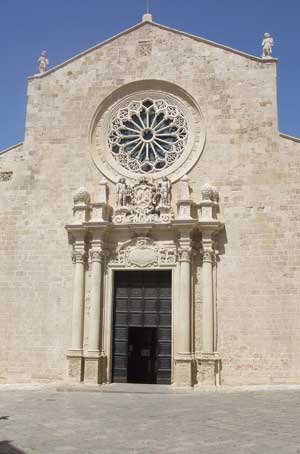
Down where the massive walls mark the entrance to the old town is a pleasant little park, the Villa Comunale. From this point the seafront stretches around the bay to the north. These are more modern areas, without the charm of the historic centre, but still pleasant for a seaside stroll with an ice cream.
Otranto beaches
The beaches actually within the town are very small – pleasant on a sunny May weekday, but extremely crowded in the peak summer season. The coastline outside Otranto is renowned for its beauty, and there are more stretches of popular beach to both the north and south. These are easiest to reach if you have a car, but there is also a summer bus service to popular seaside spots. To the north of Otranto lie the sandy beaches of Baia dei Turchi and the Laghi Alimini, large lakes close to the sea. Tourist villages were built here in the late twentieth century and the area remains a popular holiday base. A good seaside destination to the south of Otranto is Porto Badisco, a picturesque rocky cove.
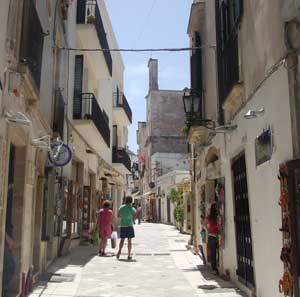
Otranto travel
The best airport for Otranto is Brindisi, though if you’re travelling around Puglia, Bari is another possibility. Both airports are served by budget flights from the United Kingdom.
Otranto can be reached by rail – a picturesque if rather slow method of travel. Otranto is on a little branch line from Maglie operated by the Ferrovie Sud Est (FSE). At Maglie there are connections to Lecce, Gallipoli and Gagliano del Capo. Lecce is just over an hour away; and sometimes there is a second change at Zollino. Train and station staff are good at helping passengers with changes – make yourself known to them if in doubt. On Sundays there is a bus replacement service.
Otranto’s railway station is a short distance from the centre of town. Leaving the station, walk downhill to a roundabout, and take the narrow lane which descends opposite, next to a little shop. There’s a supermarket off to the left if you want to stock up for a beach picnic. Continuing straight on you reach the modern seafront; the historic centre is to your right.
In the summer there is a useful service called Salento in treno e bus, which connects popular tourist destinations in the area. The routes usually operate from mid-June to early September, and several buses stop in Otranto, including buses to Santa Cesarea Terme and to Laghi Alimini. The latest information can be found on the official website (see our links panel on the right), and at the tourist information office in Otranto.
Around Otranto
We visited Otranto as a day trip from Lecce – a simple and interesting train journey. With a car the travel would be quicker, with the advantage of being able to explore the nearby coastline. The large towns of Lecce and Gallipoli are the two major destinations in this part of Puglia, but around Otranto there are plenty of smaller coastal spots which are pleasant to visit if you are driving, though hard to explore without a car. The Lonely Planet guide to Puglia and Basilicata (see links panel) has some suggested itineraries for drivers in this area. Down at the very tip of the peninsula is the holiday resort of Santa Maria di Leuca.
Otranto accommodation
Useful external links
Salento in treno e bus (timetables are under orari)
